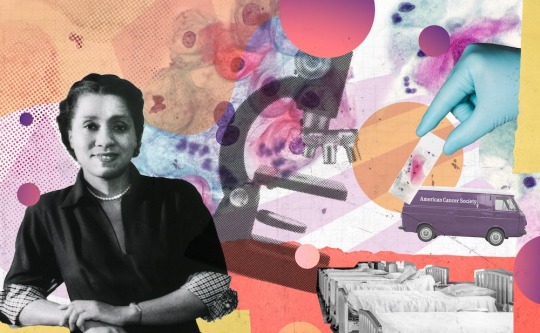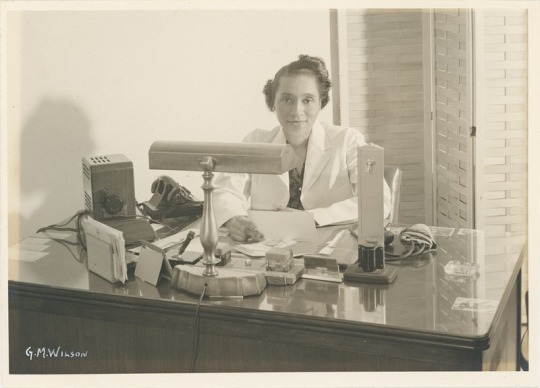#Helen Dickens | The Crusader | Cancer Van | Against Cancer
Text
How One Black Doctor Brought the Pap to the People! Helen Dickens Was a Crusader Whose Cancer Van Saved Hundreds of Lives
— March 7, 2024 | Kirstin Butler

A Collage Featuring Dr. Helen Octavia Dickens, Hospital Beds, a Microscope, Cancer Cells, and a Van with the Words "American Cancer Society" on the side. Art by Colin Mahoney. Source images from the National Library of Medicine, National Museum of Health and Medicine, Wikimedia.
In 1926, 17-year-old Helen Dickens would sit in the front row of her pre med courses at Crane Junior College in Chicago. Dickens was a dedicated student, but her seating choice in a majority-white academic environment was strategic. “If other students wanted a good seat they had to sit beside me,” she recalled in an interview years later. “This way I didn’t have to look at them or the gestures made that were directed against me.” Dickens went on to become the one Black woman in her graduating class at the University of Illinois College of Medicine, where she met further bigotry with quiet determination. “Her frame of mind was, ‘I'll work through it,’” her daughter Jayne Henderson Brown, also a doctor, told American Experience. “Which she did. It didn't stop her.”
As Dr. Dickens was wrapping up her two-year obstetrics residency, she encountered the next hurdle to her childhood dream of practicing medicine: As a Black woman, white hospitals that employed female doctors didn’t want her, and hospitals serving the Black community hired only men. She was unsure where to go next until, one day, she read a notice on a bulletin board that changed the course of her professional life. It was a letter from Dr. Virginia Alexander, another young Black female doctor, looking for women to join her practice. Alexander ran the Aspiranto Health Home as an alternative birthing center out of her three-story row house in Philadelphia, using her living room as the waiting room and her dining room for treatment. Expectant mothers—some of whom were Black and impoverished, and without other access to care—came to Alexander’s home and received unusually long postpartum care and access to birth control.
Aspiranto was “community service in private practice,” Alexander wrote to Dickens, a “socialized practice of medicine.” Dickens went to Philly, and one year after her arrival took over the home altogether at age 27. The principles behind Aspiranto would guide the way she practiced medicine for the rest of her career. “Alexander helped Dickens to formulate a consciousness around how healthcare could be used as a site of activism,” said Dr. Amina Shakir, who wrote her dissertation about Dickens.
In many ways, Dickens’s background had already primed her to be community-conscious. Her father, Charles, had been born into slavery before escaping and teaching himself to read; he passed when Helen was only eight. “I know when he died,” Dickens later told an interviewer, “he had mortgaged our house to help build a Black meeting hall.” Her father’s death resulted from an infection after a tooth extraction—antibiotics didn’t yet exist—and yet when Dickens was 12, she talked to the family dentist about the possibility of going into medicine. Her father had wanted her to be a nurse, “[b]ut somewhere along the way,” she said, “I decided that if I was going to be a nurse, I might as well become a doctor.”

Dr. Helen Octavia Dickens at her desk. Image courtesy Jayne Henderson Brown.
Over the next seven years of her directorship of Aspiranto, she got the community interaction that she’d always wanted. “It was very exciting,” Dickens remembered of her time leading the birthing center. “You were going into the homes. You were seeing all these people. You were taking responsibility for care of people.” And as one of the first Black female doctors in the city, Dickens saw firsthand the inequity of the healthcare system and the extent to which medicine often marginalized Black women. She dedicated the rest of her life to bringing the best and newest models of care to her own community.
That dedication, during the next chapter of her career, involved getting as many Black women as possible to take a brand new medical test: the pap smear. The test’s namesake was Dr. George Papanicolaou, a Greek immigrant physician who with his wife and lab technician Mary worked for decades to document its efficacy in detecting cervical cancer, then the highest-killing cancer for women. Before the pap smear, cervical cancer was detected by biopsy, which often meant it was too late to treat the disease. “By the time you have symptoms, there's already a mass,” Dr. Henderson Brown explains. “It's already metastasized—liver, lung—and it kills. So the earlier it is detected, the easier it is to prevent the spread.” Dickens, who by the early 1950s had become the first African American board-certified OB/GYN in Philadelphia, proselytized the pap smear’s potential to save her patients’ lives.

Dr. George Papanicolaou Pioneered the Lifesaving Cervical Cancer Screening that now Bears his Name.
First, though, she had to get beyond their historically well-earned distrust of gynecological treatment. The legacy of experimentation and forced sterilization of Black women made them wary of receiving care. “A lot of women are reluctant to get medical checkups that include pelvic exams,” she told the Philadelphia Evening Bulletin—which meant Dickens had to bring the test to them. She did so through clinics and workshops at Black churches; in later years, Dickens even provided free pap tests out of a mobile unit, parking an American Cancer Society van in church parking lots. Dickens also got the National Institutes of Health to fund a program to train other doctors to perform pap tests. “But she doesn't just stop there,” Shakir adds. “She also uses her work to provide statistics on Black women patients for the first time…She's really a forerunner. We take this for granted today because of the ways in which we use patient data.”
Dickens continued her crusade of improving Black women’s medical access in a variety of ways. After joining the faculty of the University of Pennsylvania’s School of Medicine in 1965, she pioneered a program for pregnant teens. And as the university’s dean for minority affairs, Dickens recruited other potential doctors from underserved communities, as she herself had once been.
All of this work she did matter-of-factly. It was, says Dr. Shakir, “her unrelenting way of making sure that the dignity and humanity of Black women was respected.” Or as her daughter notes, “I meet people all the time who say, ‘your mother delivered me’ or, ‘we really loved your mother.’ So I think her legacy is the gift she gave of healthcare to every woman who came within 10 feet of her.”
#American 🇺🇸 Experience#The Cancer Detectives#Article#Dr. Helen Octavia Dickens#Helen Dickens | The Crusader | Cancer Van | Against Cancer#Kirstin Butler#Dr. George Papanicolaou#Pioneered | Lifesaving Cervical Cancer Screening
0 notes